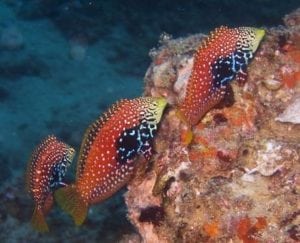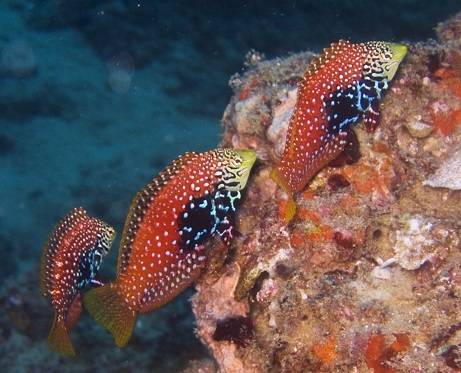Care Recommendations for Divided Leopard Wrasse – Macropharyngodon bipartitus

The Divided Leopard Wrasse, part of the Labridae family of wrasses, is a very colorful wrasse, especially the males. The male’s body contains a mosaic of oranges, yellows, reds, and greens while the female’s body is a seductive mix of yellows and oranges with blue accents. The Divided Leopard Wrasse originates from the western Indian Ocean to South Africa.
Divided Leopard Wrasse Care Recommendations
- Care Level: Expert Only
- Temperament: Peaceful
- Diet: Carnivore
- Reef Safe: Yes
- Max Size: 5-6 inches
- Minimum Tank Size: 50 gallons
Tank Requirements of Divided Leopard Wrasse
Though the Divided Leopard Wrasse is strikingly beautiful, they are quite difficult to keep in a home aquarium and should be reserved for expert aquarists. Have plenty of soft, sandy substrate in the tank for the wrasse to bury itself in overnight or when scared. Keep them in a reef tank with ample live rock for hiding and playing. Ensure the aquarium has a tight-fitting lid to avoid the majestic Divided Leopard Wrasse from escaping. While this wrasse does well with other members of its own species, it’s a good idea to introduce them into the aquarium at the same time, especially before any other larger fish. These fish shouldn’t harm the coral or the invertebrates. It is also important to avoid using copper.
Diet of Divided Leopard Wrasse
Since it can be difficult to get the Divided Leopard Wrasse onto a diet of prepared foods, experienced aquarists should keep them. With their carnivorous diet, they eat brine and mysis shrimp. They will also move around the reef feeding with other wrasses and Goatfish.
Divided Leopard Wrasse species should be kept in a good environment and a temperature between 74 and 79°F. Maintain a pH value of 8.1-8.4, a salinity of between 1.020-1.025, nitrates and ammonia levels at 0 ppm, and dKH between 8-12. Learn about care requirements for other saltwater fish.
Find more information on Wrassesby viewing our other articles
Author: Christeena

















